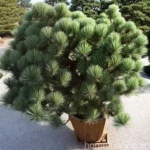Jack Pine (Pinus banksiana): A Resilient Boreal Forest Pioneer
Introduction
Jack pine (Pinus banksiana), also known as Canadian pine, is a resilient coniferous species that thrives in the harsh conditions of the boreal forests of North America. As a cornerstone of its native ecosystem, the jack pine plays a vital role in supporting wildlife habitat and promoting forest regeneration. This blog post will delve into the cultural significance, uses, optimal growing conditions, common diseases and pests, and intriguing facts about the jack pine. Furthermore, we will explore its adaptive strategies, such as fire resilience and drought tolerance, highlighting its ecological importance and potential benefits for conservation and land management.
What is a Jack Pine?
Jack pine, scientifically referred to as Pinus banksiana, is a species of pine tree native to North America. It is well-adapted to thrive in the harsh environmental conditions of the boreal forest, particularly in regions with nutrient-poor and acidic soils. This hardy tree often exhibits a unique serotinous cone adaptation that allows for the regeneration of forests after wildfires, contributing to the ecological resilience of its native habitat.
Key Takeaways – Jack Pine (Pinus banksiana)
– Jack pine is a fire-adapted and drought-tolerant coniferous species that plays a crucial role in the biodiversity and ecological resilience of boreal forests.
– The species is known for its serotinous cones, which require the intense heat of wildfires to release their seeds, prompting forest regeneration.
– Jack pine is utilized in various cultural, ecological, and commercial applications, making it an essential component of North American forest ecosystems.
Culture
In indigenous cultures, the jack pine holds significant cultural symbolism and traditional uses. The Ojibwa people, for example, valued the tree for its medicinal properties and utilized various parts of the jack pine for treating ailments and crafting essential tools. Additionally, the jack pine’s ability to thrive in challenging environments has made it a symbol of resilience and adaptability in many indigenous narratives.
Uses
The jack pine has diverse uses and applications, ranging from timber and ecological restoration to medicinal and ornamental purposes. The timber harvested from the jack pine is utilized in construction, paper production, and crafting, owing to its resilience and natural aesthetic qualities. Furthermore, its ecological importance in supporting wildlife habitat and promoting forest regeneration underscores its critical role in maintaining biodiversity and ecosystem functioning.
Water
Jack pines have moderate water requirements and can tolerate periods of drought. They are well-adapted to the dry, sandy soils often found in their native habitat and have developed mechanisms to withstand limited water availability.
Sunlight
The jack pine thrives in full sunlight and is well-suited to open, sunny environments. As such, it is an ideal species for reforestation projects and ecological restoration efforts in areas with ample sunlight exposure.
Fertilizer
In general, jack pines do not require significant fertilization, particularly in their native habitats. However, in urban or landscaping settings, a balanced fertilizer application during the tree’s early growth stages can support healthy development.
Soil
Jack pines prefer well-drained, acidic soils, such as those commonly found in the sandy and rocky terrains of boreal forests. Their ability to thrive in nutrient-poor soils is a key adaptation that allows them to dominate these environments.
Pruning
Pruning of jack pines may be necessary to shape young trees and remove dead or diseased branches. Additionally, proper pruning techniques can enhance the aesthetic appeal of these trees in landscaping and ornamental settings.
Propagation
Jack pine propagation can be achieved through seed collection and germination. Given the species’ reliance on wildfires for natural regeneration, mimicking these environmental cues in controlled settings can help facilitate successful seed propagation.
Container Popularity
The jack pine is increasingly popular as a container plant in landscaping and horticulture, owing to its appealing appearance, resilience, and ecological significance. Its adaptability to container growth makes it a favored choice for reforestation projects and urban green spaces.
Container Common Diseases
While jack pines are generally resilient to many diseases, they can be susceptible to certain fungal infections and needle blights, particularly in stressful growing conditions or crowded environments.
Disease Diagnosis
Regular monitoring of foliage health, growth patterns, and needle discoloration can help diagnose and address potential diseases affecting jack pines. Prompt identification of disease symptoms is crucial for implementing targeted management strategies.
Common Pests
Jack pines may face pest pressures from insects such as bark beetles, weevils, and caterpillars. Vigilant pest monitoring and integrated pest management practices are essential for preserving the health and vitality of jack pine populations.
Botanist’s Tips
Botanists and plant enthusiasts can contribute to the conservation and understanding of jack pines by participating in seed collection efforts, ecological restoration projects, and habitat preservation initiatives. Additionally, promoting public awareness about the ecological importance of jack pines is instrumental in supporting their long-term conservation.
Fun Facts
- The resin of jack pines has been traditionally used for medicinal purposes, particularly for its expectorant and antiseptic properties.
- The unique serotinous cones of jack pines play a pivotal role in promoting forest regeneration after wildfires, making them a keystone species in fire-prone ecosystems.
- Jack pines are known for their distinctive bluish-green needles, which contribute to their visual appeal and ornamental value in landscaping.
The unique characteristics and ecological significance of jack pines underscore their immense value in sustaining healthy forest ecosystems and supporting diverse plant and animal communities.
Links to External Resources
For further information about jack pines, their ecological importance, and conservation efforts, consider exploring the resources below:
1. USDA Plants Database – Pinus banksiana
2. The Tall Pine Pinus banksiana: A Natural History of Jack Pine
3. The Role of Pinus banksiana Lamb. in the Development of Boreal Forests
In conclusion, the jack pine stands as a remarkable and resilient species that embodies the adaptability and endurance of boreal forest plants. Its ecological, cultural, and commercial significance highlights the need for concerted efforts to conserve and sustainably manage jack pine populations to ensure the long-term health and vitality of North American forests.















